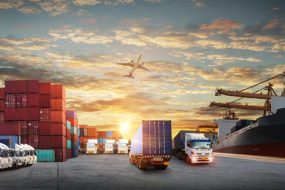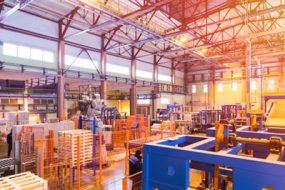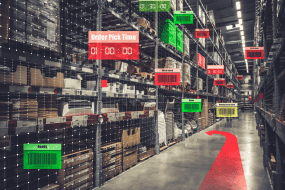

According to recent data, the fashion industry is set to transform into a trillion-dollar powerhouse by 2027, driven by shifting consumer preferences, emerging trends, and rapid technological advancements. This explosive growth will bring opportunities and challenges, particularly in fashion logistics, where service providers must stay ahead of the curve to meet evolving demands.
Fashion logistics ensures smooth operations across the supply chain—facilitating timely customer deliveries, restocking stores, and promoting sustainability. By optimising these processes, logistics providers help keep stakeholders connected and enable the industry to thrive in an increasingly fast-paced and eco-conscious marketplace.
Current Challenges in Fashion Logistics
Fast Fashion and Production Speed
The fast fashion model rides on impulses, encouraging people to buy far more than they need, leading to excessive consumption and waste. This, in turn, means that quality is often sacrificed on the altar of fast production and consumption. In the rush to produce quickly and cheaply, quantity is prioritised over quality, leading to continuous disposal.
Related Article: Supply Chain Logistics Barriers and How to Overcome Them
Environmental Impact and Sustainability concerns
The fashion industry leverages synthetic fabrics, primarily polyester—used in about 60% of global clothing production—from fossil fuels that can cause high carbon emissions while being manufactured. According to Europarl, the industry is responsible for 10% of global carbon emissions, exceeding the accumulated emissions of maritime shipping and international flights.
Additionally, synthetic fibres such as nylon and polyester are neither recycled nor biodegraded, leading to a long-term impact on waste in landfills, discharging microplastics into water channels, and further worsening the harm caused to the environment.
Supply Chain Complexities
Supply chain complexities involve several challenges, including maintaining appropriate inventory levels, ensuring quality control and compliance, managing rising transportation costs, and handling shipping conditions that may adversely affect the overall cost structure. Additionally, rapid changes in consumer trends and preferences can accelerate production and heighten delivery requirements, stretching the supply chain and reducing the efficiency of both production and distribution processes.
Importance of meeting demand for speed and sustainability
Businesses within the industry are encountering significant challenges driven by a surge in consumer expectations for ethical and transparent supply chains. Additionally, they must grapple with rising logistics costs, further complicating their ability to meet these demands. Industry players must streamline production and distribution processes for fast delivery and ensure that final products are accessible to end users when and where they need them.
Critical benefits of meeting speed and sustainability include:
- Positive Environmental Impact: The fashion industry is responsible for high global carbon emissions and environmental harm. A sustainable supply chain structure can balance ecological concerns with customer satisfaction.
- Competitive Advantage: Optimising speed and staying ahead of competitors to present and deliver products to customers gives businesses an edge in the market.
- Increased Brand Credibility and Loyalty: Delivering quality products faster enhances the market value proposition and increases the chances of differentiation.
- High-level Adaptability: Meeting the demand for sustainability and speed accelerates response times to customer demands and changes in preferences. Businesses will be better equipped to slow down or speed up their supply chain.
Achieving Sustainability in Fashion Logistics
Sourcing Sustainable Materials
Fast fashion businesses can explore innovations such as bio-based fabrics for more environmentally friendly products than traditional textiles. They can also consider local partners, manufacturers, and suppliers to reduce their brand’s transport-related emissions. Stakeholders should determine the ethical and environmental criteria they want to prioritise to guide sourcing materials. Clear direction will support decisions that best align with organisational values.
Eco-friendly Packaging and Transportation
Packaging and transportation choices have broad environmental implications. Innovations channelled at reducing emissions, pioneering principles of a circular economy, and efforts to safeguard marine ecosystems are crucial for lowering the ecological footprint.
Companies can explore eco-friendly packaging ranging from biodegradable, recycled, or renewable materials to help reduce emissions and environmental waste throughout its life cycle.
Waste Reduction and Recycling Initiatives
Investing in textile recycling technologies and zero-waste fashion initiatives will help to utilise fabric efficiently and turn post-industrial or post-consumer textile waste into new fibres. This allows stakeholders to reduce the demand for newly manufactured materials, reducing environmental impact. It also guarantees consumers access to unique and sustainable fashion options.
Meeting the Demand for Speed
Harnessing Advanced Technology and Automation
The introduction of robotics and automation in the fashion industry—across sewing, cutting and spreading, fabric inspection, distribution, warehousing, and delivery tracking—is revolutionising operations. These technologies are redefining production and logistics, reducing reliance on human labour, and making fast fashion’s production landscape more attainable. By streamlining processes, robotics and automation enhance efficiency and enable the industry to meet growing demands with incredible speed and precision.
Related Article: 8 Facts About Container Ships and Global Shipping Connectivity
Efficient Inventory Management and Distribution
Compared to many other industries, inventory management in the fashion industry is particularly complex due to seasonality and trends, which can quickly make it difficult to sell a product once it is perceived obsolete.
With efficient fashion inventory management, companies can provide the right stock at the right time while avoiding the accumulation of excess inventory. This will boost profitability, customer confidence, and satisfaction.
Streamlining Transportation and Delivery Processes
As an active player in global shipping, proper planning is crucial. Streamlining transportation and creating a fast delivery process involves providing detailed plans for every delivery. This should include the transportation methods, route, delivery tracking, contingency plans, alternative delivery methods to leverage, the projected delivery time of the goods, and warehousing.
Balancing Speed and Sustainability
Integrating Sustainable Practices into Fast Fashion
Integrating sustainable practices in fashion represents a significant shift in the industry. This approach allows for the combination of ethical considerations with aesthetic design. Upcycling, for example, involves transforming existing garments into new creations. Additionally, sustainable textile materials such as organic cotton, recycled polyester, and bamboo enhance clothing quality, innovation, and comfort.
Related Article: How Global Waste Management is Becoming More Sustainable
Consumer Education and Awareness
Over the past decades, consumer education and awareness have been pivotal in shaping the direction of the fashion industry. However, despite the tendency to prioritise trends and affordability over quality and sustainability, educating the everyday consumer about fashion products, best practices, and sustainable fashion consumption is crucial to creating a sense of responsibility and driving the required change in the fashion industry.
Key Takeaway
Several factors must be considered to make the fashion industry more sustainable: clothing production, fast delivery processes, consumer preferences, and environmental costs. By meeting the demands for speed and sustainability in fashion, the industry can reduce its environmental impact, enhance brand credibility, gain a competitive advantage, and ultimately increase customer loyalty. Technological innovations and automation can optimise product planning, track material delivery, and improve resource allocation, all while minimising waste and streamlining value chains.
ContactAramex to learn more about our warehousing and logistics services.




